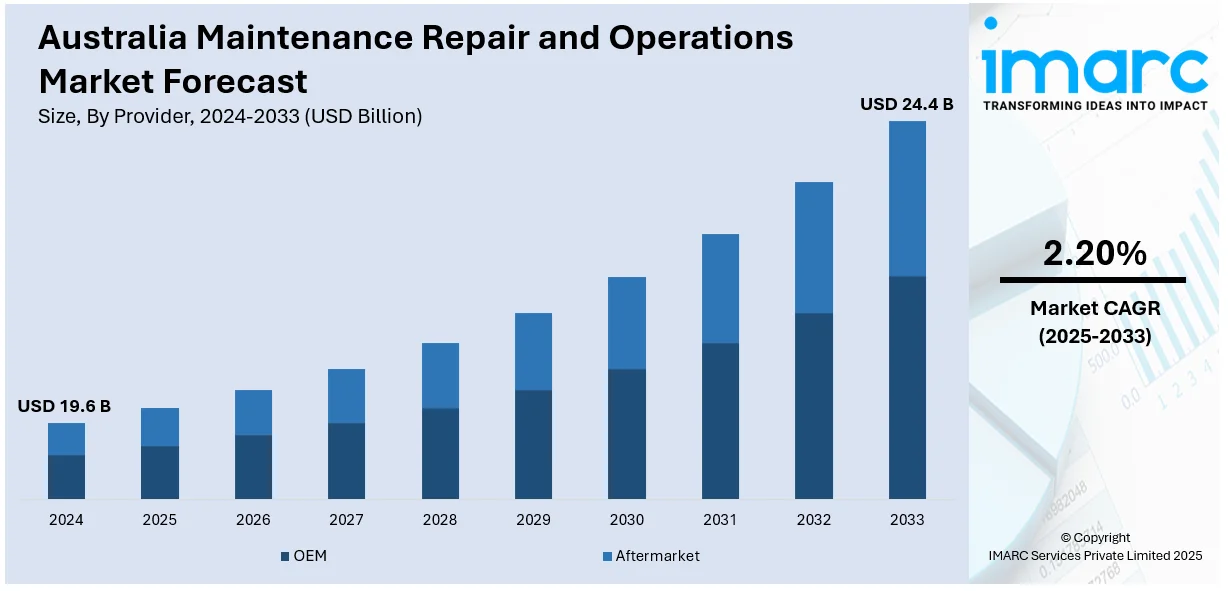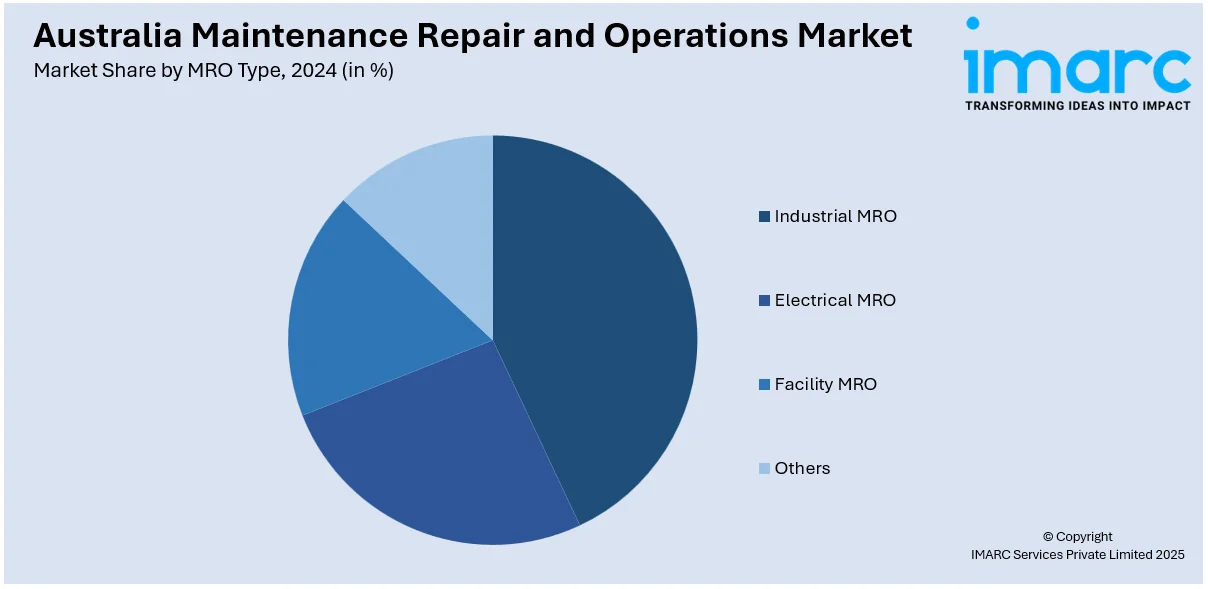
Australia Maintenance Repair and Operations Market Size, Share, Trends and Forecast by Provider, MRO Type, and Region, 2025-2033
Australia Maintenance Repair and Operations Market Overview:
The Australia maintenance repair and operations market size reached USD 19.6 Billion in 2024. Looking forward, IMARC Group expects the market to reach USD 24.4 Billion by 2033, exhibiting a growth rate (CAGR) of 2.20% during 2025-2033. The rising infrastructure development, increasing industrial automation, growing demand for predictive maintenance solutions, continual advancements in technology, stringent regulatory compliance, expanding manufacturing sectors, and a strong focus on cost-effective operations, efficiency, and sustainability across industries such as mining, construction, and energy are some of the major factors augmenting Australia maintenance repair and operations market share.
|
Report Attribute
|
Key Statistics
|
|---|---|
|
Base Year
|
2024
|
|
Forecast Years
|
2025-2033
|
|
Historical Years
|
2019-2024
|
| Market Size in 2024 | USD 19.6 Billion |
| Market Forecast in 2033 | USD 24.4 Billion |
| Market Growth Rate 2025-2033 | 2.20% |
Australia Maintenance Repair and Operations Market Trends:
Adoption of Predictive Maintenance and IoT Integration
The transition to predictive maintenance practices, using the internet of things (IoT) and data analytics to maximize asset management, is positively impacting Australia maintenance repair and operations market outlook. The conventional reactive and preventive maintenance strategies are increasingly replaced by predictive methods, which use real-time sensor information, machine learning (ML) models, and cloud-based analytics to predict failures ahead of time. This is especially strong in sectors like mining, manufacturing, and energy, where machinery downtime can cause considerable financial loss. For example, as per an industry report, predictive maintenance can lower maintenance planning time for mining and metal operations by 20–50% and cut overall maintenance costs by 5–10%. Along with this, IoT-based condition monitoring systems give real-time information about the performance of machinery so that companies can adopt precise maintenance interventions, lower the disruption in operations, and prolong asset life. Additionally, advanced predictive maintenance platforms combine past data with AI-powered insights to strengthen decision-making and overall efficiency. The rise in the adoption of digital twins, which produce virtual copies of physical assets, also boosts predictive maintenance capabilities. Australian businesses are making investments in these technologies for better asset reliability, lowest maintenance costs, and compliance with changing regulation requirements for workplace safety and environmental footprint.

To get more information on this market, Request Sample
Sustainability-Driven Maintenance Practices
Sustainability is becoming a critical factor in shaping the market, with businesses adopting environmentally responsible maintenance practices to reduce carbon footprints, enhance energy efficiency, and comply with government regulations. Additionally, companies are integrating sustainable maintenance strategies by utilizing eco-friendly lubricants, energy-efficient machinery, and recyclable spare parts, contributing to long-term operational efficiency. Also, green maintenance practices are particularly emphasized in industries such as mining, oil and gas, and manufacturing, where regulatory pressure to minimize environmental impact is intensifying. An industry report highlights that Australian customers strongly favor circularity, with approximately 64% believing that businesses should take greater action to adopt circular economy principles. This shift in consumer expectations is facilitating the Australia maintenance repair and operations market growth, as sustainability-driven practices are becoming a key focus. The implementation of circular economy strategies, such as remanufacturing and refurbishing components instead of discarding them is gaining traction as both a cost-effective and environmentally responsible alternative. Moreover, digital platforms that track carbon emissions and resource consumption are integrated into maintenance operations, enabling businesses to measure and optimize their environmental performance while maintaining operational reliability.
Australia Maintenance Repair and Operations Market Segmentation:
IMARC Group provides an analysis of the key trends in each segment of the market, along with forecasts at the country level for 2025-2033. Our report has categorized the market based on provider and MRO type.
Provider Insights:
- OEM
- Aftermarket
The report has provided a detailed breakup and analysis of the market based on the provider. This includes OEM and aftermarket.
MRO Type Insights:

- Industrial MRO
- Electrical MRO
- Facility MRO
- Others
A detailed breakup and analysis of the market based on the MRO type have also been provided in the report. This includes industrial MRO, electrical MRO, facility MRO, and others.
Regional Insights:
- Australia Capital Territory & New South Wales
- Victoria & Tasmania
- Queensland
- Northern Territory & Southern Australia
- Western Australia
The report has also provided a comprehensive analysis of all the major regional markets, which include Australia Capital Territory & New South Wales, Victoria & Tasmania, Queensland, Northern Territory & Southern Australia, and Western Australia.
Competitive Landscape:
The market research report has also provided a comprehensive analysis of the competitive landscape. Competitive analysis such as market structure, key player positioning, top winning strategies, competitive dashboard, and company evaluation quadrant has been covered in the report. Also, detailed profiles of all major companies have been provided.
Australia Maintenance Repair and Operations Market News:
- On March 21, 2025, Bombardier announced the opening of a new Line Maintenance Station (LMS) in Perth, Australia, enhancing its customer service capabilities in the region. The Perth LMS offers unscheduled maintenance and light scheduled maintenance, including Aircraft on-ground (AOG) support, for all Learjet, Challenger, and Global aircraft models. Additionally, Bombardier plans to establish a second LMS in Sydney later this year, further expanding its support network for customers in Australia.
Australia Maintenance Repair and Operations Market Report Coverage:
| Report Features | Details |
|---|---|
| Base Year of the Analysis | 2024 |
| Historical Period | 2019-2024 |
| Forecast Period | 2025-2033 |
| Units | Billion USD |
| Scope of the Report |
Exploration of Historical Trends and Market Outlook, Industry Catalysts and Challenges, Segment-Wise Historical and Future Market Assessment:
|
| Providers Covered | OEM, Aftermarket |
| MRO Types Covered | Industrial MRO, Electrical MRO, Facility MRO, Others |
| Regions Covered | Australia Capital Territory & New South Wales, Victoria & Tasmania, Queensland, Northern Territory & Southern Australia, Western Australia |
| Customization Scope | 10% Free Customization |
| Post-Sale Analyst Support | 10-12 Weeks |
| Delivery Format | PDF and Excel through Email (We can also provide the editable version of the report in PPT/Word format on special request) |
Key Questions Answered in This Report:
- How has the Australia maintenance repair and operations market performed so far and how will it perform in the coming years?
- What is the breakup of the Australia maintenance repair and operations market on the basis of provider?
- What is the breakup of the Australia maintenance repair and operations market on the basis of MRO type?
- What is the breakup of the Australia maintenance repair and operations market on the basis of region?
- What are the various stages in the value chain of the Australia maintenance repair and operations market?
- What are the key driving factors and challenges in the Australia maintenance repair and operations?
- What is the structure of the Australia maintenance repair and operations market and who are the key players?
- What is the degree of competition in the Australia maintenance repair and operations market?
Key Benefits for Stakeholders:
- IMARC’s industry report offers a comprehensive quantitative analysis of various market segments, historical and current market trends, market forecasts, and dynamics of the Australia maintenance repair and operations market from 2019-2033.
- The research report provides the latest information on the market drivers, challenges, and opportunities in the Australia maintenance repair and operations market.
- Porter's five forces analysis assist stakeholders in assessing the impact of new entrants, competitive rivalry, supplier power, buyer power, and the threat of substitution. It helps stakeholders to analyze the level of competition within the Australia maintenance repair and operations industry and its attractiveness.
- Competitive landscape allows stakeholders to understand their competitive environment and provides an insight into the current positions of key players in the market.
Need more help?
- Speak to our experienced analysts for insights on the current market scenarios.
- Include additional segments and countries to customize the report as per your requirement.
- Gain an unparalleled competitive advantage in your domain by understanding how to utilize the report and positively impacting your operations and revenue.
- For further assistance, please connect with our analysts.
 Request Customization
Request Customization
 Speak to an Analyst
Speak to an Analyst
 Request Brochure
Request Brochure
 Inquire Before Buying
Inquire Before Buying




.webp)




.webp)












